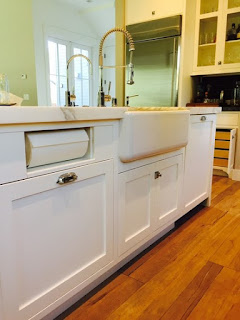9 Molding Types to Raise the Bar on Your Kitchen Cabinetry
by Shane Inman
Customize your kitchen
cabinets the affordable
way with crown, edge or other kinds of molding
Moldings can make any project look custom. When applied to
kitchen cabinetry in particular, these architectural details can help enhance
the most basic cabinet style. With the multitude of different configurations
and designs available, crown molding, edge molding and more can help
personalize your next kitchen project.
1. Traditional crown molding. Traditional crown
molding tends to be the industry standard for kitchen cabinetry. Here it has
been used to fill an empty space between the cabinets and the ceiling. Empty
space above cabinets is a common problem, because the distance fluctuates
depending on ceiling height and cabinetry height. If you have an average
ceiling height, about 8 feet high, 3 to 6 inches of crown molding can usually
help fill any kitchen cabinet gaps.
2. Stacked crown molding. Many ceilings are too high for the designer to take the
cabinetry all the way up, so crown molding becomes more of a decorative
element, like in this kitchen. This crown molding is composed of many pieces of
molding, all meticulously stacked on top of one another for a uniform look.
Moldings are detailed design accents, so some types can be expensive. They're usually priced by the linear foot and, since most are available in 8-foot lengths, it's easy for the cost to add up. One rule of thumb: The more elaborate the design, the more expensive it usually is.
Moldings are detailed design accents, so some types can be expensive. They're usually priced by the linear foot and, since most are available in 8-foot lengths, it's easy for the cost to add up. One rule of thumb: The more elaborate the design, the more expensive it usually is.

3. Stepped crown molding. This kitchen design uses upper cabinets in varying heights for a stepped look, and the molding has the same stepped appearance.
To pull off this look, you may want professional help. The placement of each piece of molding needs to be precisely calculated, and the end of the molding needs to butt up against an adjacent wall or cabinet. It may sound easy, but it definitely isn't!

4. Interior crown molding. Placed around the perimeter of this kitchen's ceiling, the crown molding immediately draws the eye upward. And it incorporates the ceiling's crown molding for continuity.
It is important to know that additional molding means an additional expense. Looking to save money? Try interior moldings made out of foam or a similar material.
5. Edge molding. Moldings can be added to almost every part of a cabinet or shelf. This homeowner or designer added molding to the outside edge of the shelving, known as an edge molding.
Decorative molding on open shelving not only adds a new design feature, but it can also add a structural element. Some shelving, depending on the span (anything over 36 inches) can bow from weight if it isn't supported correctly. Applying an edge molding to the outside edge of the shelf can prevent sagging.
6. Light molding. Also known as a light rail, molding on the bottom of cabinets helps conceal undercabinet lighting. Light molding offers huge impact for your dollar. It's often available as a standard cabinetry feature in multiple styles and lengths, meaning it has almost no impact on a budget.

7. Shoe molding. Shoe molding (sometimes known as quarter round) is applied to the perimeter of all the base cabinets here, connecting cabinetry to flooring. You can install shoe molding to match your cabinets, as shown here, or to match your flooring.
Should you have to install new flooring in your kitchen without removing the base cabinetry, shoe molding can help hide any installation imperfections by camouflaging cut edges.

8. Applied molding. Molding on walls or built-in cabinetry is called applied
molding, because the molding is adhered or applied to the surface.
The most common area in the kitchen for applied molding is the surround for the range hood. This area is often a focal point, so it demands attention to detail. Molding is usually added to coordinate or match with the door style or surrounding motifs. Although it seems like a small detail, applied molding creates balance and cohesion.
The most common area in the kitchen for applied molding is the surround for the range hood. This area is often a focal point, so it demands attention to detail. Molding is usually added to coordinate or match with the door style or surrounding motifs. Although it seems like a small detail, applied molding creates balance and cohesion.

9. Bottom molding. Molding at the bottom of the base cabinet doors and above the toe kick is known as a bottom molding. As you can see here, it helps make an island look more like furniture than kitchen cabinetry, especially when it's used in conjunction with some of the other molding elements mentioned previously.
Would you like to customize your kitchen cabinets with molding? Cabinet-S-Top can help!
We are located at 1977 Medina Road, Medina, OH 44256 ~ 330.239.3630






Excellent and helpful post… I am so glad to left comment on this.
ReplyDeleteCustom Kitchens
Kitchen And Bath Design Center
Bathroom Remodel
Flooring Installation
Best Kitchen Layouts